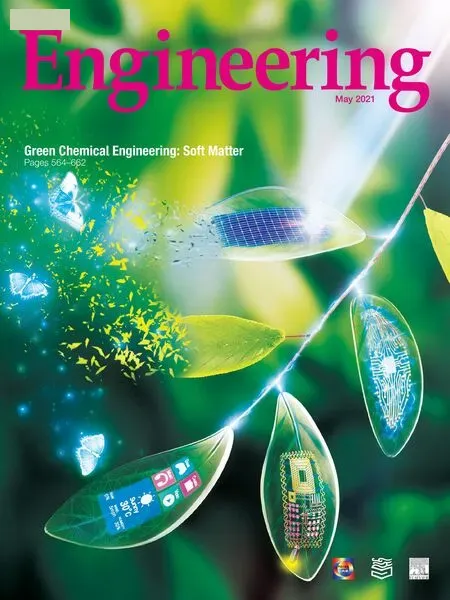Editorial for the Special Issue on Soft Matter for Green Chemical Engineering
Dvid A.Weitz ,Jin-Feng Chen
a John A.Paulson School of Engineering and Applied Sciences&Department of Physics,Harvard University,Cambridge,MA 02138,USA
b State Key Laboratory of Organic–Inorganic Composites,Beijing University of Chemical Technology,Beijing 100029,China
Soft matter refers to a class of materials that can be easily deformed,either by small forces or by thermal energy.These materials generally have both solid-like and liquid-like behaviors.They are typically characterized by some elastic coefficient whose value is many orders of magnitude less than most solids.The unit of an elastic constant is pressure or energy density.The energies that characterize materials can vary by a few orders of magnitude,from thermal energies to several electron volts,the latter of which characterize a strong covalent bond.However,the elastic coefficients of soft materials can be as much as ten orders of magnitude less than those of solids.This range must reflect a change in the length scale or the density term.Thus,the fundamental physics of soft matter always occurs at larger length scales,and it is the study of these larger length scales that gives the field its great fascination.
Soft matter includes materials,such as colloids,polymers,emulsions,gels,liquid crystals,granular materials,and biological materials,all of which exhibit mesoscopic physical properties.Topological complexity,partial ordering,and long relaxation are among the features of soft matter systems,which differentiate soft matter from conventional liquids and solids.Furthermore,we are ourselves soft matter,and thus the materials that can best interact with humans are all soft materials.
Recognition of the critical importance of environment-related problems,such as fog haze,water pollution,and the demand for eco-friendly materials,has created a different set of issues that must be addressed,and soft matter can play an important role in solving the problems.The central theme of soft matter—namely self-assembly and spontaneous formation of ordered materials with tailorable viscoelastic properties—is in good harmony with the core value of green chemical engineering,which aims to optimize engineering processes and provide a solution for sustainable development.This leads to many new and fascinating forms of soft matter research that will directly impact green chemical engineering research.
With the support of the Chinese Academy of Engineering,it is our great honor to organize this special issue on soft matter for green chemical engineering and to invite renowned researchers from all over the world to report the latest developments in the field.
This special issue contains ten papers with four reviews,three articles,two letters,and one opinion paper.The contents of these papers cover a broad range of subjects,including both theories and experiments on soft matter for green chemical engineering research.Chu et al.develop functional capsules encapsulating nanogels capable of molecular recognition,which provide a novel strategy for the facile and efficient removal of organic micro-pollutants from water.Park et al.and Shum et al.report the real-time observations and modelings of microchemical engineering processes,including nanobubble and microfluidic systems.Suo et al.and Portale et al.investigate the correlation between mesoscopic structure and performance of soft materials ranging from biodegradable to electronic materials.Russell et al.summarize recent progress in supramolecular systems constructed by host–guest molecular recognition at the liquid/liquid interface,with a focus on novel functions and applications.Zeng et al.outline recent progress in the design and fabrication of protein-based fibers using microfluidics.Finally,Jákli et al.and Yoon et al.overview the development of organic electronics and outlook their future applications in green and sustainable industry.
We would like to thank the contributors of this special issue for their valuable endeavors,which will make the special issue a success.We also thank the reviewers for their efforts.Finally,we would like to thank the editorial team of Engineering and the Chinese Academy of Engineering for their excellent work.We hope that this special issue on soft matter for green chemical engineering will stimulate more innovation in the field.
- Engineering的其它文章
- Processing,Quality,Safety,and Acceptance of Meat Analogue Products
- Advanced Devices Ease Burden of Glucose Monitoring for Diabetics
- Functional Capsules Encapsulating Molecular-Recognizable Nanogels for Facile Removal of Organic Micro-Pollutants from Water
- Nanobubble Dynamics in Aqueous Surfactant Solutions Studied by Liquid-Phase Transmission Electron Microscopy
- Degradable Plastics Are Vulnerable to Cracks
- Mechanically Strong Proteinaceous Fibers:Engineered Fabrication by Microfluidics

